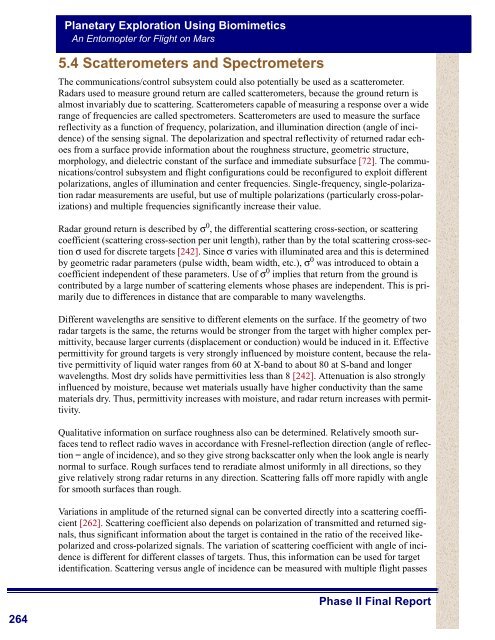Phase II Final Report - NASA's Institute for Advanced Concepts
Phase II Final Report - NASA's Institute for Advanced Concepts
Phase II Final Report - NASA's Institute for Advanced Concepts
Create successful ePaper yourself
Turn your PDF publications into a flip-book with our unique Google optimized e-Paper software.
Planetary Exploration Using Biomimetics<br />
An Entomopter <strong>for</strong> Flight on Mars<br />
5.4 Scatterometers and Spectrometers<br />
The communications/control subsystem could also potentially be used as a scatterometer.<br />
Radars used to measure ground return are called scatterometers, because the ground return is<br />
almost invariably due to scattering. Scatterometers capable of measuring a response over a wide<br />
range of frequencies are called spectrometers. Scatterometers are used to measure the surface<br />
reflectivity as a function of frequency, polarization, and illumination direction (angle of incidence)<br />
of the sensing signal. The depolarization and spectral reflectivity of returned radar echoes<br />
from a surface provide in<strong>for</strong>mation about the roughness structure, geometric structure,<br />
morphology, and dielectric constant of the surface and immediate subsurface [72]. The communications/control<br />
subsystem and flight configurations could be reconfigured to exploit different<br />
polarizations, angles of illumination and center frequencies. Single-frequency, single-polarization<br />
radar measurements are useful, but use of multiple polarizations (particularly cross-polarizations)<br />
and multiple frequencies significantly increase their value.<br />
Radar ground return is described by σ 0 , the differential scattering cross-section, or scattering<br />
coefficient (scattering cross-section per unit length), rather than by the total scattering cross-section<br />
σ used <strong>for</strong> discrete targets [242]. Since σ varies with illuminated area and this is determined<br />
by geometric radar parameters (pulse width, beam width, etc.), σ 0 was introduced to obtain a<br />
coefficient independent of these parameters. Use of σ 0 implies that return from the ground is<br />
contributed by a large number of scattering elements whose phases are independent. This is primarily<br />
due to differences in distance that are comparable to many wavelengths.<br />
Different wavelengths are sensitive to different elements on the surface. If the geometry of two<br />
radar targets is the same, the returns would be stronger from the target with higher complex permittivity,<br />
because larger currents (displacement or conduction) would be induced in it. Effective<br />
permittivity <strong>for</strong> ground targets is very strongly influenced by moisture content, because the relative<br />
permittivity of liquid water ranges from 60 at X-band to about 80 at S-band and longer<br />
wavelengths. Most dry solids have permittivities less than 8 [242]. Attenuation is also strongly<br />
influenced by moisture, because wet materials usually have higher conductivity than the same<br />
materials dry. Thus, permittivity increases with moisture, and radar return increases with permittivity.<br />
Qualitative in<strong>for</strong>mation on surface roughness also can be determined. Relatively smooth surfaces<br />
tend to reflect radio waves in accordance with Fresnel-reflection direction (angle of reflection<br />
= angle of incidence), and so they give strong backscatter only when the look angle is nearly<br />
normal to surface. Rough surfaces tend to reradiate almost uni<strong>for</strong>mly in all directions, so they<br />
give relatively strong radar returns in any direction. Scattering falls off more rapidly with angle<br />
<strong>for</strong> smooth surfaces than rough.<br />
Variations in amplitude of the returned signal can be converted directly into a scattering coefficient<br />
[262]. Scattering coefficient also depends on polarization of transmitted and returned signals,<br />
thus significant in<strong>for</strong>mation about the target is contained in the ratio of the received likepolarized<br />
and cross-polarized signals. The variation of scattering coefficient with angle of incidence<br />
is different <strong>for</strong> different classes of targets. Thus, this in<strong>for</strong>mation can be used <strong>for</strong> target<br />
identification. Scattering versus angle of incidence can be measured with multiple flight passes<br />
264<br />
<strong>Phase</strong> <strong>II</strong> <strong>Final</strong> <strong>Report</strong>

















